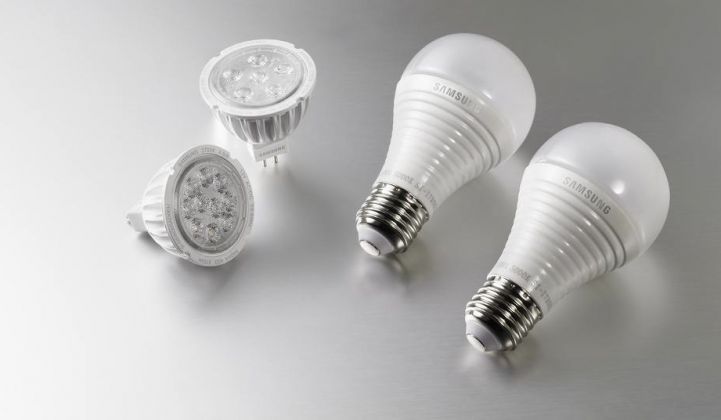The federal government’s a key buyer of energy efficient solid-state lighting, and so are the big box stores.
Swedish housewares giant Ikea made waves last week with its announcement that it will phase out all incandescent and fluorescent lights on its shelves by 2016 to go LED-only. It’s the latest in a series of challenges that major retailers (think Ikea, Home Depot, Lowe’s, Best Buy, etc.) and their lighting technology suppliers (GE, Philips, Osram, etc.) have set for themselves on LEDs, which have been poised to take over the commercial and industrial lighting sectors for years now.
With LED prices falling pretty dramatically, it’s a good bet that big-box stores like Ikea will also be slashing the prices on their consumer LED bulbs, which are still pricey compared to their CFL counterparts. That, in turn, is driving investment across the LED technology chain, from advanced power management and thermal components to integrating LEDs with household dimmer switches and office smart-lighting controls. Customers will want their new $20 (or even $5) LED bulbs to work as promised, after all.
In the meantime, the U.S. government is one of the biggest buyers of LED products in the world as part of its broader, multi-billion-dollar push for energy efficiency. The Department of Energy says solid-state lighting (SSL) could cut the U.S. lighting bill in half, and it is investing tax dollars into R&D and business adoption programs to push it into the mainstream.
The General Services Administration (GSA) manages the country’s federal properties, which makes it a good partner for LED companies. Last week, the GSA gave a nod to lighting control networking startup Lumenergi, announcing it had turned down energy consumption at 11 buildings by a whopping 63 percent.
That’s a pretty big number, though rival “smart lighting” companies like Adura, Daintree Networks, Digital Lumens, Enlighted and others say they can also achieve those kinds of savings in buildings that are egregious light-wasters. Simply turning off the lights you used to leave on all night can cut your bill in half, though few buildings are that wasteful. More typical energy savings are in the 20 percent to 30 percent range, out of a lighting budget that’s roughly one-quarter of a building’s total load.
Lumenergi, which raised a $12.7 million Series B round in 2010, also got a nod from the GSA’s Pacific Rim regional administrator, Ruth Cox, who said the platform was useful in identifying where efficiency investment made the most sense. That’s a big new trend in the industry, with startups like FirstFuel and Retroficiency promising hands-off data analytics that can pick out key buildings and classes of real estate to target for the biggest and fastest paybacks. Simple “burnout” sensors that can direct maintenance workers to faulty lights, while avoiding rote replacement of still-useful bulbs and tubes, can also save a bundle.
In the meantime, once you’ve got a network deployed in your building to manage lights, why not do other things with it? On Monday, Redwood Systems, a startup that networks LEDs and other lighting systems, said that by year’s end it would deliver a “Room Tracker” tool to manage conference rooms, all running over the same network and control platform that it uses to manage the lights.
Once again, this is a common theme in the smart lighting space. Lights are ubiquitous in buildings, making them great places to locate wireless nodes as well. Those can support all kinds of sensor data collection and control platforms, as well as integrate into master building management systems and the like. Just how all these tools will integrate and partner with building controls giants like Siemens, GE, Schneider Electric, Honeywell, Johnson Controls and the like remains to be seen, of course.
Wireless controls are growing in the industrial realm, with some acquisition activity along the way. Dust Networks, which makes low-power wireless networks using the WirelessHART standard, was acquired by Linear Technology in December.
In the meantime, the residential market remains limited to wealthy early adopters. Google says its Android@Home platform will include IPv6-compatible wireless networking based on the 6LoWPAN standard, though so far it’s only announced one partner, LED maker Lighting Science.



